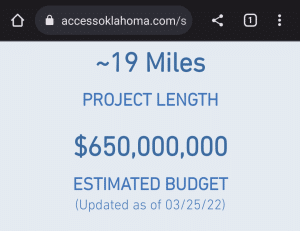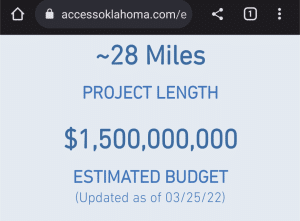
Why does a roadway cost more when the OTA is in charge?
**Based on an original cost assessment by Michael Nash on May 29, 2022. Posted with permission**
There is a very large cost discrepancy between the Oklahoma Turnpike Authority (OTA) and the Oklahoma Department of Transportation (ODOT). Both of these agencies operate in Oklahoma and build roads to serve the same population. Both agencies are headed by the same man, Mr. Tim Gatz. Both agencies hire the same pool of contractors to build their roads. With this knowledge any reasonable person must ask, why does a roadway cost more to build, widen or maintain when the OTA is in charge?
Cost Comparison per centerline-mile |
|||
| ODOT | OTA | How much more for OTA? | |
| Construction* | $3.8M to $14.3M | $45.7M | 3x-12x |
| Widening | $5M | $19M to $30.8M | 3.8x-6.2x |
| Maintenance | $7,272 | $46,948 | 6.4x |
- It costs OTA 3x-12x more per mile to construct a roadway than it would for ODOT to construct a similar roadway
- It costs OTA 3.8x-6.2x more per mile to widen a roadway than it would for ODOT to widen a similar roadway
- It costs OTA ~6.4x more per mile to maintain a toll road than it does for ODOT to maintain a toll-free highway
*We chose to use a range of estimates. At the low range are ODOT’s costs for planned new alignment projects ($3.8M per mile) and at the high range is $14.3M per mile from Florida’s estimate for new 6-lane urban highways. Citations for these estimates are provided within this blog.
Construction Cost Discrepancy
Post-March 24, 2022, OTA’s proposed South-Extension turnpike costs an estimated $34.2M per mile ($650,000,000 for 19 miles).

OTA’s East-West Connector turnpike costs an estimated $53.6M per mile ($1,500,000,000 for 28 miles).

Overall, these two OTA extensions will cost $45.7M per mile (2,150,000,000 for 47 miles).
Post-March 24th, 2022 is important for a reason. The OTA re-named portions of the proposed South and East-West Extensions the day following the passage of SB1610 in the Oklahoma Senate on March 24th. SB1610 was a (eventually stalled) bill to mandate environmental impact studies on the South Extension segment. This re-naming resulted in the East-West connector turnpike connecting to I-40 instead of the South-Extension. The re-naming effectively reduced the length of the South Extension without changing the total footprint of the turnpikes through Norman.
After March 24 the price also went up by 15%. Total cost for the 47 miles of combined East-West and South Extension turnpikes was $1.864B on March 23rd and $2.15B for the same 47 miles on March 25th. Check for yourself using web dot archive dot org and search for the ACCESS Oklahoma project pages.


Maybe the extra 15% was to cover environmental and impact studies that the OTA forgot to budget for?
How much does it cost to build a mile of road if you are not the OTA?
Determining construction costs for ODOT roads is bit harder to do since ODOT hasn’t built any brand new 6-lane highways recently. Searching the Oklahoma Transportation Construction Work Plan FFY-2023 through FFY 2030 for “new alignment” returns 3 projects totaling 8.83 miles. These projects sum to a cost of $33.8M – this calculates to 3.8M per mile (that’s a heck of a lot less than OTA’s cost for new construction of $45.7M per mile).
Google “cost to build a highway” and the first result is from the American Road and Transportation Builders Association (ARTBA) which states (ignoring federal reimbursement) “new roads can range from $2.8M to $11.2M per mile.” (Even the high range of $11.2M per miles is a lot less than OTA’s cost of $45.7M per mile!) The ARTBA website explains that construction costs can vary greatly and give the following new construction examples:
- Florida Department of Transportation estimates prices range from $2.5 million per mile for new construction of a rural road to $4.3 million for an urban arterial 2-lane road with bike lanes. The estimated cost of a new 6-lane Interstate Urban Highway would be $14.3 million per mile.
- According to the Arkansas Department of Transportation, new roads can range from $2.8 million to $11.2 million per mile, depending on the location, number of lanes, and type of road.
One thing is clear, the cost to build a mile of new roadway is high. However, even the highest estimates are far less than OTA’s costs.
Some might think that the exorbitant OTA road-building cost has to do with right-of-way acquisitions through the eminent domain process. The high OTA cost to build roads, however, has nothing to do with the fact that OTA has to buy property to build a new alignment. If you take a look at the proposed Will Rogers widening project, part of the ACCESS Oklahoma disaster, it will cost $30.8M per mile just to widen. The Turner Turnpike widening portion of ACCESS Oklahoma is a bargain at $19M per mile. However, it was designed for 6 lanes originally so the width is already there. In comparison, in 2020, ODOT estimated their costs to widen a two-lane road into a four-lane road was $5M per mile.
Therefore, the cost to widen roadways with the OTA is 3.8-6.2 times higher than ODOT.
It is truly a situation that gets worse the closer you look, isn’t it?
Maintenance Cost Discrepancy
In an open letter to the Norman Transcript, former Treasurer of the OTA Board of Directors, G. Carl Gibson, claimed the cost to maintain Oklahoma’s turnpikes to be $175M annually.
If we go ahead and assume his credentials and accept this number on his expertise, that brings the annual maintenance cost for OTA of 616.9 centerline-miles of Oklahoma toll roads to $283,676 per centerline-mile per year.
In comparison, Oklahoma Department of Transportation had an operational budget of approximately $90M for FY2020 to maintain 12,235 centerline-miles. This brings the maintenance burden for ODOT to $7,356 per centerline-mile.
Does it really cost the Oklahoma Turnpike Authority 38x more ($283,676 / $7,356) to maintain toll roads than the Oklahoma Department of Transportation to operate toll-free roads!?
No it does not.
As much as we would love to use this grandiose number, G. Carl Gibson is in err with the $175M annual cost in maintenance. According to the Oklahoma Turnpike Authority’s adopted 2022 budget, $28,962,520 in FY2020 was allocated to the Maintenance division to maintain existing toll roads, or $46,948 per centerline-mile.
This calculates to 6.4x more than it costs ODOT ($46,948 / $7,356).
OTA’s maintenance costs are 6.4x more than ODOT’s maintenance cost for each mile of roadway.
Why does a roadway cost so much more when the OTA is in charge?
These are the cost discrepancies that should be highlighted to legislators when asking about OTA’s fiscal responsibility. Likewise our legislators should be be asking the Governor, who should be asking his appointed Secretary of Transportation who directs both ODOT and OTA.
We are fortunate that, as the head of both agencies, Secretary Gatz should be able to provide an answer. Whether he will choose to is another matter. We are still waiting more than one year later.





